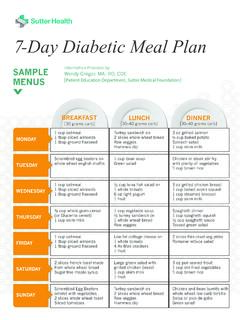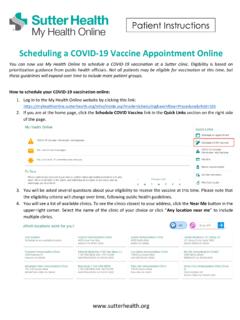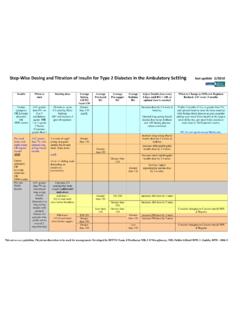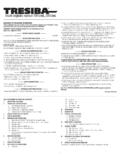Transcription of Calculating My Mealtime Insulin
1 Using a Sliding Scale and Fixed Meal dosing ScheduleUsing a sliding scale dosing for your Mealtime Insulin means you have a fixed dose for your food and varying correction dose based on blood sugar level. This method assumes you eat a steady amount of carbohydrates (carbs) in your meals. Following a sliding scale is as easy as steps Food DoseAmount of Insulin to take based on what meal you are eating: breakfast, lunch dinner and snack (see back page).2. Correction Dose Amount of Insulin to add to your food dose. 1. Test your blood sugar. 2. Use your Insulin sensitivity factor to determine your dose (see back page).3. Do not use more often than every 4 hours, except when directed to by your Meal Dose Amount of Insulin you take before you eat a meal.
2 1. Add your food and correction doses together and draw this amount into syringe or dial up in Insulin pen. 2. Inject 15-30 minutes before you start eating (depending on the brand of Insulin you take). Calculating My Mealtime Insulin +=MealFood Dose (Units)BreakfastLunchDinnerSnacksMeal Blood Sugar LevelCorrection Dose(ISF of 1:50)Correction Dose(ISF of 1:25)Correction Dose(ISF of 1:____)Under 70 Treat low blood sugar. 15 grams of carbs is a typical extraNo extra130-149No extraAdd 1 Unit150-174 Add 1 UnitAdd 2 Units175-199 Add 1 UnitAdd 3 Units200-224 Add 2 UnitsAdd 4 Units225-249 Add 2 UnitsAdd 5 Units250-274 Add 3 UnitsAdd 6 Units275-299 Add 3 UnitsAdd 7 Units300-324 Add 4 UnitsAdd 8 Units325-350 Add 4 UnitsAdd 9 UnitsStep 1: Determine Your Food DoseYour food dose will stay fixed to the meal you are eating breakfast, lunch, dinner or snack.
3 This is because you will eat a steady amount of carbs for each meal. Your healthcare provider will help you fill in the 2: Use Insulin Sensitivity Factor (ISF) to Determine Correction DoseMy Insulin Sensitivity Factor (ISF): _____meaning 1 unit of rapid- or short-acting Insulin will lower my blood sugar by _____ : Your Insulin sensitivity factor is one to 50 (1:50). You just measured your blood sugar, it is 182, and you are getting ready to eat lunch. Your lunch food dose is 3. How much should your meal dose be?Answer: 3 (food dose) + 1 (correction dose) = 4 units (meal dose)
















